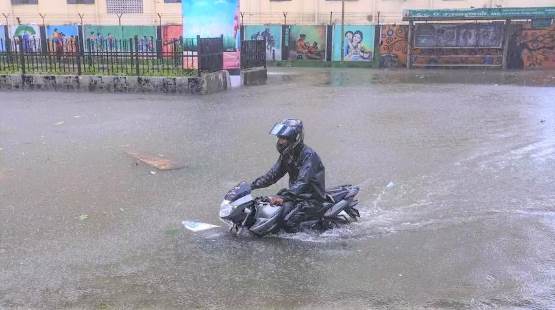Apart from Chennai, dozens of cities might go underwater; Check to learn more

Apart from Chennai, dozens of cities might go underwater; Check to learn more
By: Pune Pulse
December 7, 2023
Pune: The latest heavy rainfall in Chennai, caused by Cyclone Michaung, has once again highlighted the susceptibility of Indian cities to climate-induced disasters. Chennai was inundated with over 40 cm of rain within 48 hours by December 4, 2023, underscoring the escalating climate crisis facing urban India.
Cyclone Michaung caused extensive damage in Andhra Pradesh and Tamil Nadu, claiming over a dozen lives and leaving a trail of destruction.
The most striking images showed residential buildings submerged and cars washed away in waterlogged streets. While the recent flooding and destruction were a result of the cyclone, they were not the only contributing factors.
Chennai experienced a historic flood in 2015 due to heavy rainfall from the northeast monsoon, underscoring the consequences of inadequate urban planning and institutional capacity. The causes of such flooding are varied, including heavy rainfall, inadequate drainage systems and the inability of rivers to manage high discharge levels. Urbanization exacerbates the situation, with encroachments on major water bodies and ecologically sensitive zones.
Chennai’s flat terrain further complicates matters, impeding efficient water drainage. Chennai’s challenges are part of a wider narrative of climate vulnerability across Indian cities. Kolkata and Mumbai, for instance, face significant risks from sea-level rise, tropical cyclones, and riverine flooding. These densely populated areas are already experiencing the impacts of climate change, including increased rainfall intensity, flooding, and heightened drought risks. Research commissioned by the World Bank Group warns that India, being close to the Equator, will experience higher sea-level rises, posing a severe threat to coastal cities through saltwater intrusion and potential impacts on agriculture and groundwater quality.
According to a report by the Intergovernmental Panel on Climate Change (IPCC), rising sea levels threaten to submerge 12 coastal cities in India by the end of the century. Additionally, over seven million coastal farming and fishing families are already feeling the effects, with coastal erosion estimated to lead to the loss of about 1,500 square kilometers of land by 2050. Low-lying coastal areas and river deltas are highly susceptible to increased flooding, posing a risk of displacing millions and impacting livelihoods and infrastructure in cities like Mumbai, Kolkata, and Chennai.
The risk of flooding due to climate change extends beyond coastal cities to inland areas, with cities in Bihar, Himachal Pradesh, and Uttarakhand experiencing monsoon-triggered flooding and landslides. Delhi also faced heavy flooding earlier this year, with experts attributing the causes to encroachment of floodplains and accumulation of silt. The changing pattern of extreme weather events is affecting over 40% of Indian districts, with flood-prone areas becoming drought-prone and vice versa.
Addressing these challenges requires a multifaceted approach, including strict enforcement of building codes, anticipation of climate-related disasters in urban planning, and measures such as coastal embankments and watershed management to mitigate flood risks. Efforts such as the Mumbai Climate Action Plan (MCAP) 2022 aim to enhance climate resilience through evidence-based planning, while improvements in hydro-meteorological systems and flood warning systems can aid in preparing for and responding to disasters. As climate change intensifies the natural water cycle, Indian cities must integrate climate risk into their development plans and actions to adapt to this new reality. The recent flooding in Chennai serves as a stark reminder and a call to action for building cities capable of withstanding the severe impacts of a changing climate.









